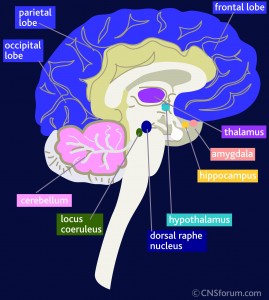I found the following post by Elvira Aletta, Ph.D. to be an excellent summary of techniques we can employ in our quest for sanity. To visit her original post on Psych Central, click here. I have reprinted it below.
1. Knowledge is power. The more you know about how your brain works the better. So here’s a little neuro-psychology lesson.

What you need to know is that the most primitive part of our brains, the inner bit in the middle, is the limbic system, also called the reptilian brain because it’s the oldest most primitive part. Within that is the amygdala. For our purposes it’s enough to know that scientists believe that everything we need to keep ourselves, and therefore our species, alive originates here, including fear in its rawest form.
Our frontal lobes are in the newest part of the brain, the neo-cortex. Our ability to judge, to filter out right from wrong, to determine appropriate from inappropriate behavior, real vs. unreal, reasonable vs. unreasonable resides here. It’s the part that keeps us civilized and steady, among other things.
Behavioral scientists theorize that when we perceive a threat we respond on a primitive, non-thinking level first, because survival is more important than being right or wrong. The amygdala sends a hormonal signal that ‘there’s a nasty threat out there!’ to the adrenal glands. Adrenalin is released into the blood, kicking off the autonomic nervous system response, revving up the entire body to either run away, flight, or duke it out, fight, with whatever is about to kill us.
Anxiety occurs when this system goes into overdrive because there is nowhere for the body to run and nothing for it to fight. The threat is abstract. What’s firing off the system are scary ideas, not a saber-toothed tiger. All that adrenalin, and no quick way to metabolize it, causes anxiety.
Medical and non-medical treatments for anxiety are all about keeping the amygdala from running amuck and the frontal lobes engaged.
2. Know the Bad News: The bad news is if you have been dealing with anxiety for a long time and you have a family history of people who have anxiety [or depression], chances are you will be dealing with anxiety in some way for the rest of your life.
3. Know the Good News: Anxiety is very treatable. Once you have good treatment that empowers you and you learn skills to manage the anxiety, (and keep your frontal lobes engaged) it can never hurt you so much, ever again. Really!
4. Immediate relief may be as easy as learning to breathe deeply, getting enough good quality sleep, cutting out alcohol and caffeine for a while, and starting an exercise regime. Many patients have reported that just making these healthy changes reduced their anxiety significantly.
5. Take responsibility: In his book “10 Days to Self-Esteem,” Dr. Burns says only you can make yourself feel bad. This is a powerful concept. Anxiety is highly correlated with low self-esteem, lack of assertiveness and people-pleasing. I have not met one person with anxiety disorder who wasn’t really nice. If they didn’t care so much what others thought, they wouldn’t have so much anxiety. Doesn’t seem fair, does it?
Remember the flight attendant who instructs you to put the oxygen mask on yourself first before helping those dependent on you. What good are you to others if you keel over, caring for them? Give yourself permission to take the starring role of your life. That’s not conceited, that’s healthy.
6. Use an anxiety thermometer and take your temperature throughout the day. 0 can be calm as a cat taking a nap. 10 could be full blown panic attack mode. Then rate the numbers in between.
As you feel the anxiety blip up or down take note of what is going on and what you’re thinking. This way you may be able to notice patterns, like always spiking up to 8 when it’s time for a staff meeting, or going down to 2 when American Idol is on. Over time this exercise will help you recognize your triggers.
7. Fore warned is fore armed. Your triggers are whatever causes your anxiety to blip up to six or higher. Triggers can be people, places, things, ideas, anything. Knowing what your triggers are can be a big step to developing an effective strategy to confront the anxiety. Think of healthy adaptive responses to your triggers, such as giving yourself a pep talk before going into that staff meeting. Become aware of the yellow flags that can warn you anxiety is coming and you can nip it in the bud.
8. Learn about Cognitive Behavioral Therapy. CBT is scientifically proven effective in the treatment of anxiety and it’s close sister in mood disorders, depression. Built on the simple premise that our thoughts influence how we feel, we can use CBT to raise our awareness of how harmful our automatic thoughts can really be. A useful book to learn more is “When Panic Attacks: The Drug Free Therapy That Can Change Your Life,” by David Burns.
Using these tools is easier if you have the support and guidance of a therapist who knows CBT. You can find one through this website or contact me.
9. Get smart. Anxiety thrives on ignorance and has a nasty habit of feeding on itself. Once we’re anxious we get scared of getting more anxious which causes more anxiety. Avoidance and ignorance works to reduce anxiety in the short term but it always comes back unless confronted. Avoidance never resolves the anxiety, it just puts it behind a blind. Once we face our fears using CBT tools and knowledge, we become empowered, so that the next time they make an appearance we can think, “Oh, you again, well, I’ve faced you before and I’m ready, so I can face you again.”
10. Remember #1! It’s all about keeping your frontal lobes engaged. As long as we can keep thinking realistically and reasonably we can reduce that crazy, useless, flight/fight autonomic nervous system response otherwise known as anxiety. Easier said than done, but it can be done with CBT, appropriate medication if indicated and all of the above. In the treatment of anxiety there is a lot to be hopeful about.
To get Dr. Aletta’s website, click here.
* Click here to subscribe to Beyond Blue and click here to follow Therese on Twitter and click here to join Group Beyond Blue, a depression support group. Now stop clicking.

